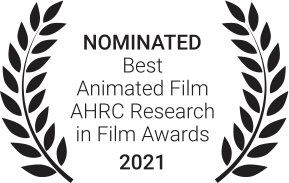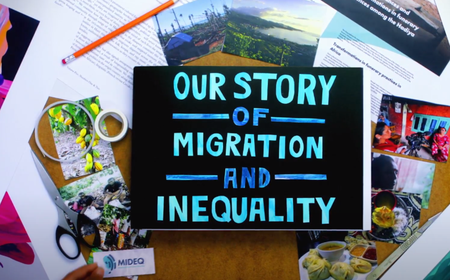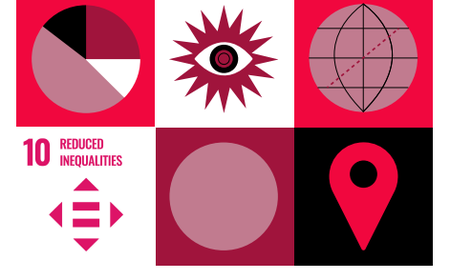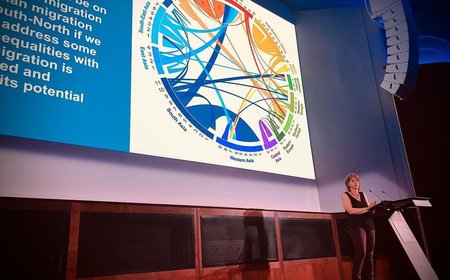The Story of Migration

MIDEQ and PositiveNegatives launched The Story of Migration, an animation in seven languages that aims to tell the complex story of the relationship between migration and global inequalities.
The animation, illustrated by Karrie Fransman, is based on a script written with MIDEQ’s partners in 11 countries in the Global South and challenges many of the ideas that currently dominate media representations of migration. It highlights:
- The fact that migration between the countries of the Global South accounts for nearly half of all international migration, 70% in some places
- The complex reasons why people move including poverty, conflict and love
- The fact that inequalities are increasing and have been exacerbated by the COVID-19 pandemic
- The role of inequalities including gender and age in shaping migration decisions
- Inequalities in the ability to travel safely between the countries of the Global South
- The economic, political, social and cultural contributions made by migrants
- The implications of migration for those ‘left behind’
The animation engages a wide range of audiences in MIDEQ’s work and highlights the importance of understanding global migration from the perspectives of those living and working in the Global South. It reflects the importance of international research projects such as MIDEQ that are able to generate new knowledge on migration issues, challenge dominant political and media narratives and ultimately contribute to efforts aimed at improving the lives of those living in the Global South. Most importantly it puts inequalities at the heart of the story.
The film can be viewed in English, Portuguese, Tamil , Malay, French, Mandarin and Hadiyissa on YouTube. The animation will be released in additional languages over the coming months.
Commenting on the animation Professor Heaven Crawley, Chair in International Migration and Director of MIDEQ said:
“For too long the story of migration has been dominated by the views and interests of the Global North. This story has focused on issues of security and border controls, ignoring the complex factors that drive people to move in different parts of the world. Migration is a part of our history and will inevitably be part of our future. If we want migration to work for everyone then we need to better understand and address the structural inequalities – poverty, gender inequalities, racism – that drive migration and limit its potential to contribute to development.”
Dr Benjamin Worku-Dix, Founding Director, PositiveNegatives said:
“The Story of Migration has been the most collaborative animation we’ve made at PositiveNegatives, co-produced with 17 partners across 11 countries and during the most challenging times when the COVID-19 pandemic has meant we needed to rely on new technologies to successfully collaborate and physically work independently. We wanted to make a film that engages a varied global audience from young students to senior policy makers in the complexities of migration and inequality. We think the film does exactly that.”
Dr Seng-Guan Yeoh, Co-Investigator in MIDEQ’s Nepal-Malaysia corridor said:
“The making of this short animation is itself a re-discovery of the complex entangled threads of the historical, socio-economic and geo-political forces structuring our perceptions and understanding of human mobility in the world today.”
Dr Jailson de Souza e Silva, Co-Investigator in MIDEQ’s Haiti-Brazil corridor said:
"Narratives regarding migration have been historically constructed by Northern countries. They only contemplate migration and the person who migrates upon notions of need, lack, absences and demands. MIDEQ seeks to construct a different narrative, in which migrants are regarded upon their possibilities, potentialities, potencies and inventive capability. Migrants are themselves the subjects of their histories, which they construct in new times and spaces.”
Dr Bonayi Hubert Dabiré Co-Investigator in MIDEQ’s Burkina Faso-Côte d’Ivoire corridor said:
“The images conveyed and amplified by the various presses, especially Western ones, of migrants drowning in the Mediterranean Sea, colliding with the barbed wire of the European borders, piling up on the island of Lampedusa, etc., end up making people believe that Europe is the main destination of migrants from the South, which is quite wrong. For the most part, migrants from the South are heading for the South. This research project, designed and implemented with Southern researchers and focusing on South-South migration, will set the record straight and hopefully show the potential of South-South migration and the awareness that South-South migrants should have of this potential.”



